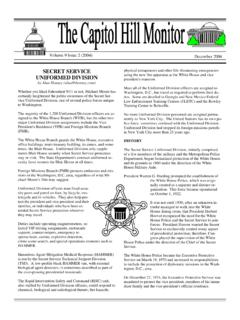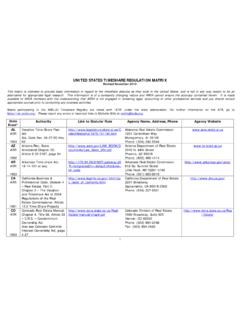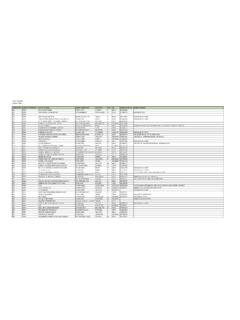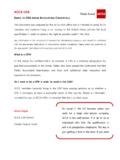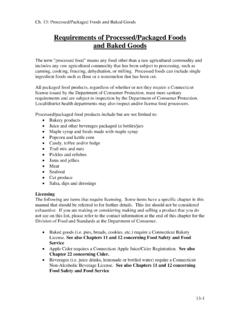Transcription of 165 Capitol Avenue H UMAN 860.713.5100 D July 8, 2013 RE ...
1 DT: July 8, 2013 DEPARTMENT OF ADMINISTRATIVE SERVICES STATE OF CONNECTICUT 165 capitol avenue Hartford, CT 06106-1658 FAX Donald J. DeFronzo Commissioner RE: Statewide Family and Medical Leave Policy - Revised TO: AGENCY HEADS & AGENCY HUMAN RESOURCES ADMINISTRATORS PURPOSE This General Letter is to provide a statewide Family and Medical Leave Policy to ensure consistent application and implementation of 5-248a, 5-248b and Personnel Regulations 5-248b-1 through 5-248b-9 inclusive.
2 Additionally, this document incorporates the requirements under amended regulations to the federal Family and Medical Leave Act (FMLA) effective January 16, 2009 and March 8, 2013. Therefore, any and all individual agency policies on this topic are hereby deemed obsolete and agencies shall comply with the instructions specified herein. Supplemental information is available to State employees and agency Human Resources professionals via the DAS publication, Understanding Family and Medical Leave (A Primer for Connecticut State Employees).
3 BACKGROUND Legislation passed at both federal and state levels provides eligible employees with job-protected leave for certain family and medical reasons. The federal Family and Medical Leave Act (FMLA) was enacted by Congress in 1993 and was amended in 2008 and 2009 to extend additional leave rights to families of members of the Armed Forces. The federal Department of Labor issued revised regulations regarding the federal FMLA effective January 16, 2009 and March 8, 2013. Connecticut s statute governing family and medical leaves for public sector employees ( 5-248a) was enacted in 1988, and was most recently amended in May 2009 ( 09-70) to include military family caregiver leave.
4 ELIGIBILITY To be eligible for federal FMLA, employees must have at least 12 months of total service (in the aggregate) and have worked at least 1,250 hours in the 12 months immediately preceding the commencement of leave. ( Hours worked does not include time spent on paid leave sick, vacation, PL, administrative or unpaid leave. However, overtime hours and military leave do count toward the 1,250-hour requirement.) To qualify for state family/medical leave, employees must be a permanent employee with the state as defined in 5-196(19).
5 A state employee may be eligible for: Federal FMLA only, State family/medical leave only, Both federal FMLA and state family/medical leave, or Neither. An Affirmative Action/Equal Opportunity Employer An employee who is eligible under only one law receives benefits in accordance with that law only. If the leave qualifies for both federal FMLA leave and state family/medical leave, the leave may count against an eligible employee s entitlement under both laws and run concurrently.
6 Federal FMLA (though not state family/medical leave) may run concurrently with a Workers Compensation absence. REASONS FOR LEAVE The circumstances covered under either the state family/medical leave or federal FMLA or a combination of the acts are as follows: The birth of employee s child or adoption of a child by the employee (both state and federal); The placement of a foster child with the employee (federal only); The serious illness (state) or serious health condition (federal) of a child*, spouse** or parent.
7 The serious illness (state) or serious health condition (federal) of the employee; For an employee to serve as an organ or bone marrow donor (state only); Military family leave o Military caregiver leave (state and federal) o Qualified exigency leave (federal only) *The term child means: a biological, adopted or foster child, stepchild, child of a person standing in loco parentis, and a child of whom a person has legal guardianship or custody, and who is under age 18 years or 18 or older and incapable of self-care because of a mental or physical disability.
8 For purposes of caring for a son or daughter under state and/or federal military caregiver leave, there is no age restriction. **The term spouse includes same sex marriages under the state family/medical leave and federal FMLA leave. AMOUNT OF LEAVE Except as described below, eligible employees are entitled to a maximum of 12 weeks of unpaid leave or paid leave with earned accruals in a twelve-month period under federal FMLA and are entitled to a maximum of twenty-four (24) weeks of unpaid leave* within a two-year period under state family/medical leave.
9 For purposes of military caregiver leave, both federal and state law provided additional leave time. Under federal FMLA, an eligible employee is entitled to a maximum of 26 weeks of unpaid leave or paid leave with earned accruals during a single 12-month period to care for a covered servicemember (including a covered veteran) who was injured while on active duty in the Armed Forces. Under state family/medical leave, an eligible employee is entitled to a maximum of 26 weeks of unpaid* leave in a 2-year period to care for a covered servicemember who was injured while on active duty in the Armed Forces.
10 Under both state and federal law, military caregiver leave is a one-time benefit per servicemember per injury. Where possible, leave time granted under the state s family/medical leave law will run concurrently with the federal FMLA entitlement. * Employees are required to exhaust their sick time before going on state family/medical leave if the leave is for their own illness. Employees may request to use vacation, personal or comp time when on state family/medical leave but this time cannot be used to extend the 24-week entitlement.










